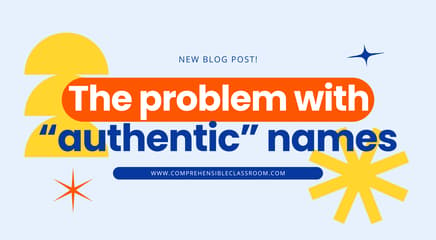If you're anything like me, you love a good manipulative activity. Here are some common manipulative activities used by language teachers:
- sequencing events from a story that are printed on strips of paper
- matching chunks of authentic texts to paraphrased summaries
- sorting quotes into groups based on who said or would have said each one
You probably have baggies of brightly-colored, laminated sets of cards and strips of paper stashed away in your now-empty classroom, and you're wishing you could use them now.
The bad news is that those baggies will have to wait for a future semester for students to open them and spill their contents onto the floor. The good news is that it is actually quite easy to bring most manipulative activities into the digital realm! All you need is a computer, a file for the original activity (PDF, Doc, PPT, etc.), and Internet access.
Ready? Let's go!
How to create digital manipulative resources in Slides™
First, let's make sure we understand what the end goal is! You're going to follow the steps that I lay out to create Google Slides™ presentations that students will use in the Editing mode. They will use the grab tool to physically rearrange different activity "cards" around on each Slide in a logical order or arrangement that you have assigned to them.
Check out this example:
In this Digital Jigsaw activity (adapted from the one linked in this post), students are placing square-shaped cards on the grid such that the sentence halves on either side of every divide come together to form coherent facts about Cinco de Mayo.
Here is how YOU can take an existing file and turn it into a Digital Manipulative activity with just a few simple steps. Watch the tutorial here, or read the Step-by-Step instructions below:
Prep the Original File!
To create your Digital Manipulative, you'll be using screenshots of the components. You want these screenshotted component cards to be easy for students to read and error-free. Here are some things you might need to do to prep the original file:
- Check for spelling and grammar errors!
- Turn off Spellcheck so that no words are underlined in red dots, therefore appearing as though they are misspelled.
- Rotate text elements so that they are easier to read (right-side up or sideways, but not upside down)
Take Screenshots
With the file open and zoomed in so that the text is readable, use a Screenshot tool to take pictures of each card. On a Mac, I can click Command + Shift + 4 to bring up the Screenshot tool, which allows me to select the section of the screen that I want to take a picture of. Take one screenshot of each component.
Create a Slides file
Now, open Google Drive and Create a New Slides resource. Delete any existing text boxes from the template so that the slide is completely blank.
Add Placeholders
Use the Shapes tool to create "placeholders" for the finished product. Your placeholders should look like a blank version of the finished product. In this example, students will be arranging cards with writing on them in a 3x4 grid, so I created a 3x4 grid out of plain squares. Students can clearly see that they need to place each text card on top of one of the gray placeholders!
 Optional: Download the slide as a JPEG then add it as the Slide background to keep students from accidentally moving around your placeholders as they try to manipulate the activity cards.
Optional: Download the slide as a JPEG then add it as the Slide background to keep students from accidentally moving around your placeholders as they try to manipulate the activity cards.
Upload the activity cards
Now, go to Insert » Images and upload all of the screenshots that you just took to your Slide. All of the screenshots should now appear as moveable image cards on your Slide!
Resize the activity cards
An easy way to make all of your activity cards the same size is by using the Format Options menu. Click on one of the cards, then go to Format » Format Options » Size & Rotation. Check Lock Aspect Ratio, then input a new Width. The program will automatically adjust the Height so that it keeps the same proportions as the original screen shot. Try a few different Widths until the card is the size that you want it! Then, open the Format Options for each of the remaining cards and adjust them to the same Width. Voilà ! You now will have a set of cards that are all the same size.
Move the cards to the side
Now, drag your cards to the margins of the Slide. It doesn't matter whether they are actually on the Slide or not, because students will be working with the Slide in Editing mode. They'll be able to see everything on the slide AND in the margins!
Add instructions
Writing clear instructions can be the most challenging part of this process. If students are familiar with the activity in the classroom context, you might not have to be quite as detailed as if this is a totally new-to-them task. Here are some tips that I have found to make instructions clear:
- Add a full-page Instructions Slide at the beginning of the Slides presentation.
- Create an example, using unrelated text, that shows how the activity pieces are supposed to fit together.
- Place one or two activity cards on the grid of Placeholders so that students have a starting point.
Send the file to your students
If you are using a Learning Management System (LMS) like Google Classroom, Schoology, or Canvas, sending the file to your students to complete is easy. Follow the standard procedures of that LMS to send links out to your students! If you're a Schoology teacher, watch this tutorial created by Meghan Loveless:
If you are not already set up on a Learning Management System, it is still easy to send this file to your students for completion.
- Adjust Sharing Settings so that "Anyone with the link can view".
- Highlight the entire URL of the Slides presentation
- Delete everything after the last backslash– starting with the word "edit".
- Replace what you just deleted with the word "copy". The URL should now end in " .../copy".
- Send the adjusted URL to your students! When they click on it, it will prompt them to Make a Copy of the file and add it to their own Drive.
Completing and submitting work
When your students open the file that you've sent them, they will need to open it in Slides and keep it in Editing mode. They will NOT "View" the presentation. Note: some older mobile devices, like early iPads, will not allow presentations to be opened in Editing mode, because the Slides app is not compatible with very old Operating Systems. Students on very old devices may not be able to complete these activities!
With Slides in Editing mode, they will drag the activity cards around on the Slide until every card is correctly arranged over a placeholder. Once everything is in place, they should share the Slides presentation with you. They can do this through their Learning Management System, or they could use their Share settings to share it with you as a collaborator– whatever makes the most sense for your situation!
Units that contain Digital Manipulatives
If you're looking to keep teaching some of your favorite topics but incorporate Digital activities, including manipulatives done through Slides™, try out our Distance Learning units:
- Daily Check-in
- El Cinco de Mayo
- La comida latina (Somos 1 Unit 8)
- El Cucuy (Somos 1 Unit 9)
- Las lágrimas del cocodrilo (Somos 1 Unit 10)
- Los deportes (Somos 1 Unit 11)
- El secreto (Somos 2 Unit 6)






